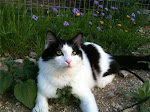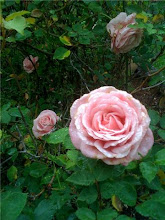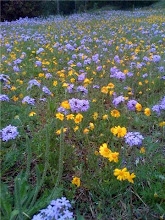

Just got back from Abiquiu, New Mexico and settling into my typical routine. I attended the Traditions in Western Herbalism conference held at Ghost Ranch - an enchanting part of the earth famous for inspiring Georgia O'Keefe to create breathtaking paintings of the heart stopping landscape. This land sings through your body as if communicating you have entered the heart and soul of mother earth. Sounds kind of goofy, I know...but that land does impact you once you are there, I'll tell you that much. The bright blue sky radiates as it touches the orange red earthy hills...ahhhh.
There were so many well known and published herbalists there, I hardly know how to begin featuring each one. I'll simply start in sequential order of my favorite classes attended.
Paul Berger: North American Institute of Medical Herbalism and webmaster of medherb.com

"Diet, sleep, activity...these are the horses that carry the chariot of vitality!"~ Paul Bergner. I just love Paul's energy and view on vitalist principles of herbal medicine. He and I have something in common, we both healed our bodies through careful study of food intolerance and sensitivities. He once suffered from food intolerance leading to immune system disturbances and diabetes. Today, he is symptom free and medical doctors agree he does not present with any signs of having diabetes. He had been so ill, it affected his eyesight and was once considered legally blind. That is certainly not the case now.
Paul's classes focused on vitalism. The "vitalist regimen" prescribes to knowing our bodies have the power and ability to heal themselves. Just as our bodies went astray into the path of disorders and disease - given the right nutrition and support plan it is believed that with time and study the body can correct itself and begin the path towards healing and wellness. Food is a large part of providing basic nutrition for endemic deficiencies. The thought here is one I've believed for some time - food can be building; however, if you do not tolerate a certain food, it can work against your body systems...weakening them... and in time, lead to illness. We all have intolerance to some degree - and with patience and discipline, cutting out the foods that lead to feeling poorly (mental fog, indigestion, sluggishness) can help your body focus on staying healthy. Poor sleeping can lead to health disorders, as well - Paul's studies show we need about 8.5 hours of sleep for optimal wellness. Also, 60-90 minutes of activity per day is essential for our health.
Paul's clinical experience shows his clients are routinely cured by eliminating food intolerance. He has had success relieving people from autoimmune disorders, chronic URI, GERD, chronic lower bowl diseases - all by helping his clients eliminate problem foods. If you know me, you know this hits home - having cured myself of GERD and Gastritis and bowel disorders all by eliminating certain foods.
Howie Brounstein: the Columbine's School of Botanical Studies

"I love herbs - I want to slather them all over my body" ~ Howie Brounstein. He had me at "slather" - as an herbal body care maker, I had to laugh when he said this during his GI Protocol discussion. Howie is a very entertaining herbalist/teacher. Here are a few talking points from his class:
- the GI tract can be inflamed and disrupted by veganism and extreme food habits. The key here is to remove, replace, repair, reinoculate, and restore the gut.
- Remove: all foods that irritate you; you know the ones. We all have them.
- Replace: those foods with nutritive foods you tolerate well - keeping a well balanced diet...ensuring you are getting magnesium - since magnesium deficiency is prominent in most people today. Take in bitter foods we have lost in western diet. Try dandelion leaves in your salad, aromatic mints, basil. Tasting bitter greens before a meal stimulates digestion and gets you systems flowing.
- Repair: Demulcents and astringents are needed. Demulcents (slippery elm, marshmallow root) sooth and coat irritated tissue while astringents (plantain) tighten, contract, and tone tissue.
- Reinoculate: get probiotics, keifer, fermented foods in your belly to help build up the "good guys" and keep the overgrown bad bacteria in check.
- Restore: keep up all of the above to a better feeling better functioning GI tract.
7 Song: Northeast School of Botanical Medicine

What a wonderful way to end the conference! A scenic and informative herb hike in the hills of Ghost Ranch with herbalist 7Song (seen here holding avena sativa or wild oats). Here are just some of the many plants he featured:
- Cotton Wood: deltoid shaped leaves with 10 or more teeth per side gives you a good indication you are looking at a cotton wood tree. The bark is "blocky". A tea can be made of the inner bark then soak in it for pain relief. Willow is stronger; however cotton wood bark is good enough when you are in the woods and need immediate pain relief. The medicine also resides in the buds of the tree - the sticky resin is considered the medicine and can also be a deterrent for insects. the inner bark medium is rich with solicilates - which has anti-inflammatory properties.
- Oats - Avena Sativa: good nervine to feed the central nervous system. Calming effects. Harvest in milky stage. (I personally love this plant and take a few drops of tincture each day and have really noted the difference).
- Blue Spruce: related to the pines; resins good for first aid bandages while out in the woods. Collect the resins and heat them over a fire then cover wound with it to create a seal "nature's band-aid". It is antimicrobial and nontoxic. Applying it on while hot also draws out cactus spines. You can also make a tea from the needles but it does cause a heating/drying effect so if your constitution is hot/dry avoid this tea.
- Lavender: tincture is said to be good for belly aches related to stress (taken in very small amounts).
- Ragweed: counterintuitive, but it can be very helpful as an antihistamine herb when made into tincture before flowering.
In another blog entry, I'll cover Mathew Wood's discussion on the muscular skeletal system and which herbs are helpful as well as other helpful tips I picked up along the way.
In the meantime, please enjoy these beautiful pictures of Abiquiu's Ghost Ranch:


















+and+wildflowers+loving+the+field.jpg)








No comments:
Post a Comment